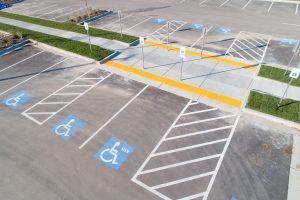Oklahoma Bar Journal
Is Your Law Firm Compliant With Title III of the Americans With Disabilities Act?
By Angie Barker

As attorneys, we spend countless hours ensuring our clients comply with laws and regulations. But many law firms overlook their obligations as service providers under the Americans with Disabilities Act (ADA).[1] This oversight represents not only a potential legal liability but also a missed opportunity to overtly demonstrate our profession’s commitment to equal access to justice. Title III of the ADA,[2] which prohibits discrimination on the basis of disability in places of public accommodation, applies directly to law firm offices. It creates specific obligations every law firm must understand and properly implement.[3]
Our profession has a unique responsibility to model compliance with civil rights legislation. But when law firms fail to provide accessible facilities, they create barriers that prevent individuals with disabilities from obtaining legal representation, consulting with attorneys or participating in office-based legal proceedings. This article examines the specific Title III requirements that apply to law firm offices – focusing on practical compliance strategies for parking lots, building entrances, reception areas, restrooms and conference rooms.
UNDERSTANDING TITLE III'S APPLICATION TO LAW FIRMS
Unlike Title I, which addresses employment discrimination, or Title II, which applies to federal, state and local government services, Title III specifically governs public accommodations operated by private entities.
The scope of Title III extends beyond mere physical accessibility. In general, the statute requires that “goods, services, facilities, privileges, advantages, and accommodations of any place of public accommodation by any person who owns, leases (or leases to), or operates a place of public accommodation.”[4]
Title III of the ADA defines places of public accommodation broadly to include “office of an accountant or lawyer, pharmacy, insurance office, professional office of a health care provider, hospital, or other service establishment.”[5] Given that a lawyer’s office is specifically mentioned, the question as to whether a law firm’s office falls under Title III of the ADA is a settled matter.
Unfortunately, not every attorney or law firm understands or adheres to the statute. In 2010, the Department of Justice (DOJ) brought an action against attorney Patric LeHouillier and his law firm, LeHouillier & Associates PC, located in Colorado Springs, Colorado. The DOJ claimed Mr. LeHouillier violated the civil rights of the opposing counsel’s client (who fit the definition of disabled under the ADA) by denying her entry to his law office for a deposition being conducted in his firm’s conference room. The matter culminated in a consent decree replete with obligations, remedial actions, monetary relief and civil penalties against Mr. LeHouillier and his law firm.[6] The parties and the court agreed that both Mr. LeHouillier[7] and his law office[8] were places of public accommodation covered by Title III of the ADA.
This example demonstrates that ensuring your clients, employees and anyone else invited into your law firm can access not only the physical premises but also the full range of legal services offered by your firm applies to both lawyers and law firms.
COMPLIANCE: KEY OBLIGATIONS
Law firms must comply with both the general provisions of Title III and the specific architectural standards of the 2010 ADA Standards for Accessible Design (2010 standards).[9] These obligations include, but are not limited to:
- Removal of Architectural Barriers: Law firms must remove architectural barriers in existing facilities where such removal is “readily achievable,” meaning easily accomplishable without much difficulty or expense.[10] Determining whether barrier removal is readily achievable is made on a case-by-case basis by considering the specific nature and cost of the removal, the overall resources of the business and other relevant factors. This requirement is ongoing and must be reassessed as circumstances change. Additional factors required in new construction are not discussed in this article.
- Policy Modifications: Law firms must make reasonable modifications to policies, practices and procedures when necessary to provide equal access, unless the law firm can demonstrate that such modifications would fundamentally alter the nature of the services provided.[11]
- Audiovisual and Remote Services: Law firms must provide appropriate services to ensure effective communication with employees and clients who have hearing, vision or speech disabilities.[12] This includes accessible websites and documents in accessible formats.
PARKING FACILITIES: THE FIRST POINT OF ACCESS
Accessible parking represents the initial compliance challenge for many law firms, yet it is often the most visible indicator of a firm’s commitment to accessibility. In guidance provided for the 2010 standards, the term “facility” is used to include both parking lots and parking structures. The 2010 standards also establish specific quantity and technical requirements.
Quantity Requirements
For parking facilities, the number of required accessible spaces follows a precise formula:
- One to 25 spaces: One accessible space is required
- 26 to 50 spaces: Two accessible spaces are required
- 51 to 75 spaces: Three accessible spaces are required
- 76 to 100 spaces: Four accessible spaces are required
- 101 to 150 spaces: Five accessible spaces are required
- 151 to 200 spaces: Six accessible spaces are required
- 201 to 250 spaces: Seven accessible spaces are required
- 301 to 400 spaces: Eight accessible spaces are required
- 401 to 500 spaces: Nine accessible spaces are required
- 501 to 1,000 spaces: 2% of the total parking spaces
- 1,001 and over: 20 accessible spaces plus one for each additional 100 spaces, or fraction thereof, over 1,000[13]
Note: One of every six accessible spaces must be van accessible, with a minimum of one van-accessible space required, regardless of the total number of accessible spaces provided.[14]
Technical Specifications
Accessible parking spaces must meet specific dimensional requirements. Standard accessible spaces must be at least 96 inches wide with an adjacent access aisle at least 60 inches wide.[15] Van-accessible spaces require a minimum width of 132 inches when adjacent to an access aisle of at least 60 inches. Alternatively, van-accessible spaces can have a minimum width of 96 inches if the adjacent access aisle is also a minimum width of 96 inches.[16] The access aisle must be part of an accessible route to the building entrance and must be marked (striped) to discourage parking.[17]
The parking surface must be stable, firm and slip resistant, with a slope not exceeding 1:48 (roughly 2%) in any direction.[18] Proper signage is mandatory, with signs displaying the international symbol of accessibility mounted at least 60 inches above the ground.[19] Van-accessible spaces require additional signage indicating “Van Accessible.”[20]
Note: For parking spaces, several states and even some municipalities have technical requirements in their building codes that are greater than the minimum standards required by the ADA. If your state or municipality falls in this category, follow the more stringent requirement. In general, specific provisions that offer additional protections to people with disabilities override those that are less protective.
Common Compliance Issues

Many law firms encounter problems with parking compliance due to several recurring issues. Inadequate maintenance of accessible spaces, such as allowing debris accumulation or failing to repair surface damage, can render parking spaces unusable. Improper signage placement or missing van-accessible designations are frequent violations discovered during compliance reviews.
Perhaps most problematic, some firms attempt to designate accessible spaces in locations that do not provide the shortest distance to the accessible entrance of the building. The 2010 standards require that accessible parking spaces be located on the shortest accessible route from the parking space(s) to the accessible entrance.[21] This means that accessible spaces cannot be relegated to remote areas of parking facilities.
BUILDING ENTRANCES: ENSURING ACCESS
The entrance of a law firm sets the tone for client relationships and must comply with specific accessibility requirements. Title III requires that all new construction and new alterations provide accessible entrances, while existing structures must remove barriers where readily achievable, and it gives several examples to consider.[22]
Door and Doorway Requirements
In general, door openings must provide a minimum clear width of 32 inches, as measured when the door is open to 90 degrees.[23] The 2010 standards provide technical specifications for nearly every type of door and approach possible. Those specifications can be found in its various figures and tables.[24] Along with approach, maneuvering space is a necessary consideration. These specifications can also be found in the above-referenced figures and tables.
Door hardware presents another critical compliance area. Handles, pulls, latches, locks and other operating hardware must “be operable with one hand and shall not require tight grasping, pinching, twisting of the wrist.”[25] Lever-style handles generally meet this requirement, while round doorknobs almost exclusively do not.
The force required to open an entrance door is also a factor that should be considered. “The force required to activate operable parts shall be 5 pounds (22.2 N) maximum.”[26]
Threshold and Surface Requirements
“Thresholds, if provided at doorways, shall be 1/2 inch (13 mm) high maximum.”[27] The standards allow for an exception in existing or altered thresholds. Those may be a maximum of three-fourths inch high if they also have a beveled edge on each side that is not steeper than 1:2.[28]
The area immediately inside and outside of each door must have a level landing with specific dimensional requirements. Generally, the landing must extend at least 18 inches beyond the latch side of the door to allow for adequate maneuvering space.[29]
Floor surfaces at entrances to and throughout the interior of the law firm must be stable, firm and slip resistant.[30] These seemingly minor details can make the difference between independence and dependence for clients with mobility impairments.
Additional Entrance Considerations
Law firms with multiple public entrances must carefully consider which entrances are accessible. While not every public entrance must be accessible, at least one accessible entrance must be provided.[31] For ground-floor law offices, this typically means ensuring that the primary entrance is accessible. Best practices dictate making the primary entrance accessible whenever possible to avoid creating separate and potentially stigmatizing situations.
RECEPTION AREAS: CREATING ACCESSIBLE SPACES
Law firm reception areas serve multiple functions beyond simply being a client accommodation. They project the firm’s professional image, provide space for completing intake forms and often serve as the initial interface between a firm and its clients. Title III requirements for reception areas focus on ensuring that these spaces serve all clients equally.
Seating and Clear Floor Space
To the maximum extent feasible, reception areas should provide wheelchair-accessible seating options or designated clear floor[32] space that can accommodate a wheelchair. It is important to arrange the reception area to provide adequate clear floor space for employees and clients who are wheelchair users to maneuver on a path of travel to other areas of the firm intended for their use.
Reception Service Counter Access
Service counters in reception areas must be accessible to individuals using wheelchairs.[33] Alternative accommodations may include providing a nearby accessible surface for writing or document review or ensuring that staff can move to an accessible location to interact with clients who use wheelchairs. However, these alternatives should supplement – not replace – accessible counter design. Again, consider whether these alternatives might cause a client to feel stigmatized.
RESTROOM ACCESSIBILITY: MEETING ESSENTIAL NEEDS

Accessible restrooms are among the most technically complex areas of ADA compliance, yet they are essential for ensuring that clients and employees with disabilities can comfortably use law firm facilities. The 2010 standards provide extremely detailed specifications that address the needs of individuals with various types of mobility impairments when using public restrooms.
Note: Specific exceptions apply to several of the requirements discussed herein.
Single-User Restroom Requirements
Many law firms provide single-user restrooms. As discussed earlier, entrance doors must provide at least 32 inches of clear width and must be operable with hardware that does not require tight grasping or twisting. Door swing space should not overlap with the clearance required for any fixture (sink, urinal, etc.), but doors are allowed to swing into the required turning space.[34] Clear floor space within the restroom must be at least 30 inches by 48 inches to accommodate wheelchair maneuvering.[35]
Multi-User Restroom Considerations
If your firm offers multi-user restroom facilities, ensure that at least one toilet stall in each restroom is accessible and follows all guidelines for door width, door swing, maneuvering space, clear floor space and toe clearance. These detailed specifications can be found in Chapter 6 of the 2010 standards.[36]
Toilet and Grab Bar Technical Specifications
Toilets must be positioned with the centerline between 16 and 18 inches from the side wall.[37] The height of the toilet seat must be between 17 and 19 inches above the finished floor.[38] These specifications ensure that individuals can transfer from wheelchairs to the toilet with appropriate positioning and leverage.
Grab bars are mandatory and must meet specific installation requirements for circumference, shape, location and distance. These specifications can also be found in Chapter 6 of the 2010 standards.[39] Grab bars must be capable of supporting 250 pounds of force.[40] This specification often requires that blocking be installed behind the wall surface to ensure proper mounting is achieved.
Sink and Mirror Technical Specifications
Accessible sinks must have a rim no higher than 34 inches above the finished floor.[41] Knee clearance must be provided underneath the sink, and hot water pipes and drainpipes must be insulated or configured to protect against contact injuries and scalding.[42]
Mirrors located above sink and faucet areas must be mounted with the bottom edge of the reflective surface no higher than 40 inches above the finished floor.[43] This allows individuals seated in wheelchairs to use the lavatory mirror effectively. Dispensers (soap, paper towels, etc.) and other accessories must be located within accessible reach ranges (48 and 54 inches depending on approach) and must be operable with one hand without tight grasping or twisting.[44]
CONFERENCE ROOMS: ACCESSIBILITY CONSIDERATIONS
Conference rooms present unique accessibility challenges for law firms, as these spaces must accommodate not only employees and clients with mobility impairments but must also ensure effective and confidential communication during client meetings. The conference room should be located along an accessible route.
Table and Seating Accessibility
Conference room tables must provide accessible seating positions that have adequate knee clearance, and the table height should be between 28 and 34 inches above the finished floor.[45] Conference rooms must also provide adequate maneuvering space to comply with seating.
Audiovisual and Communication Equipment Considerations
Many law firms use audiovisual equipment in conference rooms for presentations, video depositions and remote consultations. This equipment must be accessible to employees and clients with disabilities. Often, it is as simple as using closed captioning or large print documentation in a sans serif font.
COMPLIANCE: STRATEGIES AND RISK MANAGEMENT
Effective Title III compliance requires a proactive approach that integrates accessibility considerations into all aspects of law firm operations. Compliance should not be viewed as a one-time project but as an ongoing commitment that evolves with changes in technology, regulations and the firm’s physical space.
Conducting Accessibility Audits
Regular accessibility audits provide the foundation for effective compliance. These audits should be conducted by qualified professionals who understand the technical requirements of the ADA standards, the practical needs of individuals with disabilities and the operational needs of law firms. Audits should address not only architectural barriers but also policies, procedures, communication and digital presence.
The auditor should include a consultation with individuals with disabilities who can provide practical insights into the usability of the firm’s facilities and services. This consultation can reveal barriers that might not be apparent from a purely technical review of the 2010 standards.
Developing Remediation Plans
When accessibility barriers are identified, law firms must develop prioritized remediation plans, also known as transition plans, that address the most significant barriers first. The readily achievable standard requires ongoing assessment of what barrier removal is feasible as the firm’s resources and circumstances change.
Remediation or transition plans should include specific timelines, budget allocations and responsibility assignments. Plans should also address interim accommodations that can be provided while permanent barrier removal is being implemented.
Staff Training and Policy Development
All law firm staff who interact with clients should receive training on accessibility awareness and appropriate interaction with individuals with disabilities. This training should address both legal requirements and practical considerations for providing effective and considerate client services.
Firm policies should clearly articulate the firm’s commitment to accessibility and should provide specific procedures for handling accommodation or modification requests from employees and clients. These policies should be regularly reviewed and updated to reflect changes in best practices, regulations and technology.
MOVING FORWARD: EMERGING ISSUES AND CONSIDERATIONS
The landscape of ADA compliance continues to evolve, with new technologies and changing work patterns creating both opportunities and challenges for law firms seeking to maintain accessible facilities and services.
Technology Integration
Modern law firms increasingly rely on technology for client services, from online consultation platforms to electronic document management systems. While these technologies can enhance accessibility for some individuals with disabilities, they can also create new barriers if not properly designed and implemented.
Inaccessible websites are as exclusionary to online clients with disabilities as steps leading to the entrance of your law firm are to physical clients with disabilities. Law firms should ensure that their websites comply with applicable accessibility standards, such as the Web Content Accessibility Guidelines (WCAG).[46] To do this, consider the typical factors that create accessible websites: proper text size, text/background color and contrast, alternative text for image description, captioning for videos, accessible online documents and keyboard (rather than mouse-only) navigation.
Cases and Settlements Worth Noting
While this article’s focus is on ADA compliance in physical spaces, law firms should not ignore their digital presence. The DOJ continues to take steps to enforce online accessibility not only under Title II but also under Title III of the ADA. While the DOJ established WCAG 2.1 Level AA[47] as the standard for Title II compliance, it promotes following the technical standards for web accessibility in private businesses. In its effort to enforce digital accessibility, the DOJ has entered into settlement agreements with companies such as Rite Aid Corp., Teachers Test Prep Inc., H&R Block and Peapod LLC because their respective websites were found to discriminate against people with disabilities. What do these four companies have in common? They maintain an online presence in addition to their physical spaces.
In contrast to the aforementioned settlement agreements, the U.S. District Court for the Southern District of New York recently held that a web-only business was not subject to Title III requirements.[48] The key fact in the court’s decision was that the business in question did not maintain a physical space; the court acknowledged that a majority of other district courts have held that a website is a place of public accommodation only if it is connected to a physical location. This is an important point to consider if your firm is purely virtual, but it should not be used as an excuse to ignore accessibility compliance.
The majority of law firms maintain both physical spaces and publish websites and, therefore, fall under the requirements of Title III. Regardless, maintaining ADA-compliant websites is the prudent decision, and all law firms should strive to achieve and maintain WCAG 2.1 compliance to mitigate legal risk.
CONCLUSION
ADA Title III compliance represents both a legal obligation and a professional opportunity for law firms. By creating accessible facilities, services and websites, law firms demonstrate their commitment to equal justice and expand their ability to serve all members of their staff and communities.
Effective compliance requires ongoing attention to both technical specifications and practical usability. Law firms should view accessibility not only as a legal requirement but as an integral part of professional excellence. The investment in accessibility pays dividends in terms of employee and client satisfaction, risk management and professional reputation.
As the legal profession continues to evolve, accessibility must remain at the forefront of facility planning, technology adoption and service delivery. Law firms that embrace this challenge will find themselves better positioned to serve their staff and communities and fulfill our profession’s commitment to accessible justice for all.
The path to full accessibility may seem complex, but the destination is clear: law offices that welcome all clients with dignity and provide equal access to legal services. This goal is not only required by state and federal law but is demanded by the principles of justice that define the legal profession itself.
ABOUT THE AUTHOR
 Angie Barker is an accessibility rights attorney, consultant and adjunct professor with over 20 years of ADA compliance and fair housing advocacy experience. Her practice spans employment, premises liability, housing law, construction compliance, veterans' rights, elder law and education law – anywhere the ADA touches. Ms. Barker's unique experience as both a legal practitioner and an ADA consultant enables her to identify architectural barriers, policy failures and regulatory violations. She teaches real estate and property law at Rose State College.
Angie Barker is an accessibility rights attorney, consultant and adjunct professor with over 20 years of ADA compliance and fair housing advocacy experience. Her practice spans employment, premises liability, housing law, construction compliance, veterans' rights, elder law and education law – anywhere the ADA touches. Ms. Barker's unique experience as both a legal practitioner and an ADA consultant enables her to identify architectural barriers, policy failures and regulatory violations. She teaches real estate and property law at Rose State College.
ENDNOTES
[1] Americans with Disabilities Act of 1990, 42 U.S.C. §12101 et seq. (1990).
[2] 42 U.S.C. §12101 et seq.
[3] 42 U.S.C. §12182(a).
[4] 42 U.S.C. §12182(a).
[5] 42 U.S.C. §12181(7)(F).
[6] Consent Decree, U.S. v. LeHouillier, 1:09-cv-02582-MSK-MEH (D. Colo. April 5, 2010) [hereinafter Consent Decree (LeHouillier)].
[7] 42 U.S.C. §12181(7)(F); 28 C.F.R. §36.104.
[8] 28 C.F.R. §36.104.
[9] U.S. Department of Justice, Civil Rights Division, 2010 ADA Standards for Accessible Design, 40 P.S.G. 5673 (U.S. Dept. of Justice, Civ. Rights Div., 2010).
[10] 28 CFR 36.304(a).
[11] 42 U.S.C. §12182(b)(2)(A)(ii).
[12] 42 U.S.C. §12182(b)(2)(A)(iii).
[13] 2010 ADA Standards §208.2.
[14] Id. at 2.4.
[15] Id. at §502.2.
[16] Id. at §502.2.
[17] Id. at §502.3.3.
[18] Id. at §502.4.
[19] Id. at §502.6.
[20] Id.
[21] Id. at §208.3.1.
[22] 28 C.F.R. §36.304(a) and (b).
[23] 2010 ADA Standards §404.2.3.
[24] Id. at §404.2.3-404.2.4.3.
[25] Id. at §309.4.
[26] Id.
[27] Id. at §404.2.5.
[28] Id.
[29] Id. at §404.2.4.1.
[30] Id. at §302.1.
[31] Id. at §204.4.1.
[32] 28 C.F.R. §35.151(b)(4)(ii)(A).
[33] 2010 ADA Standards §904.1.
[34] Id. at §603.2.3.
[35] Id. at §305.3.
[36] Id. at §600.
[37] Id. at §604.2.
[38] Id. at §604.4.
[39] Id. at §609.
[40] Id. at §609.8.
[41] Id. at §606.3.
[42] Id. at §606.5.
[43] Id. at §603.3.
[44] Id. at §604.7.
[45] Id. at §902.3.
[46] W3C World Wide Web Consortium, Web Content Accessibility Guidelines 2.1, (May 31, 2025, 4:32 p.m.), www.w3.org/TR/WCAG21.
[47] Id.
[48] Mejia v. High Brew Coffee Inc., No. 1:2022cv03667 – Document 33 (S.D.N.Y. 2024).
Originally published in the Oklahoma Bar Journal – OBJ 96 No. 7 (September 2025)
Statements or opinions expressed in the Oklahoma Bar Journal are those of the authors and do not necessarily reflect those of the Oklahoma Bar Association, its officers, Board of Governors, Board of Editors or staff.
